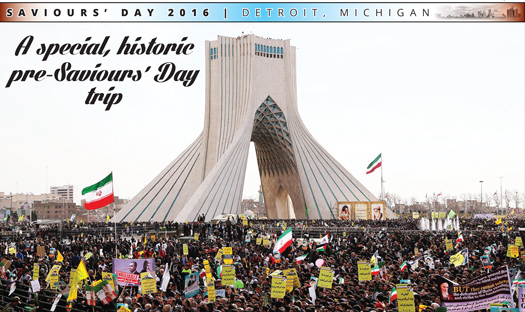Just back from Iran:
The Minister was invited to Iran by the Coordinating Council For Islamic Publicity, a non-governmental organization, and as a special guest at Iran’s freedom anniversary on Feb. 11. Min. Farrakhan attended but did not speak at the celebration. He was warmly received at the gathering and participated in private meetings. One session included a dialogue with former Foreign Minister Ali Akbar Velayati, who now heads the Center for Strategic Research and remains an advisor to Supreme Leader Ali Khamenei and an important figure in Iran.
The Minister was also an honored guest at a symposium, the “International Seminar of Foreign Guests On the 37th Anniversary of Victory of the Great Islamic Revolution of Iran,” where presenters laid out the importance of the Iranian revolution, its history and its place in history.
Some presenters expressed pride that the Muslim state exists despite nearly four decades of opposition from the United States and a tense relationship with Saudi Arabia, a major U.S. ally in the region.
Farrakhan Calls On Black People To Help Redevelop Detroit
DETROIT (WWJ/AP) – Nation of Islam leader Louis Farrakhan is calling upon black people to unite and help redevelop Detroit.
Farrakhan’s remarks came Sunday as the Chicago-based movement wrapped up its four-day Saviour’s Day convention in Detroit, which has a black majority population.
Farrakhan, 82, told a crowd at Joe Louis Arena: “Detroit can be a great, great city again.” He says “opportunity is here, but the disunity is also here.”
“Detroit can be the new mecca,” Farrakhan said. “It can be great, great city. And it’s 83 percent black.”
His speech, entitled “Divine Instructions: Commands for 2016,” was streamed live on the National of Islam website.
In it, Farrakhan covered a wide variety of topics including politics. He criticized politicians on both sides of the aisle for not helping black people, mentioning laws “written by Republicans” that he says deny black people the same opportunities as whites. About Democrats, he said: “They look right at you because they want your vote…I don’t care what they promise.”
Farrakhan also encouraged black men to protect black women, and said black women should use discretion with men who may not be worthy.
[Full Video] Divine Instructions: Commands for 2016 http://dld.bz/ehdPc #SD16DET
Touching on the topic of wealth, Farrakhan compared well-paid professional black athletes to slaves.
“Please don’t put up another basketball court and think you’re giving back to the back community,” he instructed. “Basketball courts are a training ground for a basketball plantation.”
Farrakhan recalled how slave owners once put men up on an auction block where buyers could evaluate them.
“Well, that’s that what you do in sports. You run up and down the field, show them how swift you are, how clever you are,” he said. “And they’re sitting there, watching you, timing you: ‘That’s a good one. I’ll get him. I’m drafting him.’”
Farrakhan cautioned black people who do earn money through sports or otherwise to be disciplined and use their earnings![]() more wisely.
more wisely.
“Go downtown and see how disciplined you can be, and keep your plastic in your pocket,” he urged.
Farrakhan had some kind words to say about Detroit Police Chief James Craig, who helped to provide a motorcade for Farrakhan, at his request, earlier in the week — “like that given to President Obama and others when they come to the city.” On Wednesday, police cars![]() were stationed at entrance ramps along I-94 from Metro Airport to Dearborn.
were stationed at entrance ramps along I-94 from Metro Airport to Dearborn.
“I really like (Chief Craig). I know you aren’t supposed to like police, but there are some good ones,” Farrakhan said.
“…Every Muslim is not good and it would be good to get some of them out of our ranks. I believe he is a good man and we can work together to make Detroit the No. 1 city in America for police-community relations.”
[Watch a video of the speech].
The event was last held two years ago in Detroit, where Nation of Islam’s roots trace back roughly 85 years.
Farrakhan spoke last fall in Washington, D.C., to mark the 20th anniversary of the Million Man March, an event he spearheaded.
*** The Farrakhan visit to Iran also included a new introduction of a drone ceremony.
On Wednesday, the United States Armed Services Committee published an unclassified intel report in conjunction with Director of National Intelligence James Clapper. Part of the report reads:
We judge that Tehran would choose ballistic missiles as its preferred method of delivering nuclear weapons, if it builds them. Iran’s ballistic missiles are inherently capable of delivering WMD, and Tehran already has the largest inventory of ballistic missiles in the Middle East. Iran’s progress on space launch vehicles—along with its desire to deter the United States and its allies—provides Tehran with the means and motivation to develop longer-range missiles, including ICBMs.
Thursday’s meeting between Rouhani and Farrakhan will not be the first. The duo have rubbed shoulders in the past, including at the United Nations in 2013 at a party hosted by Iran where Farrakhan called President Barack Obama a murderer over the death of Libyan leader Muammar Gaddafi after he was killed by rebel fighters. “We voted for our brother Barack, a beautiful human being with a sweet heart,” Farrakhan said at the time. “Now he’s an assassin.”



